Black Metal, Death Metal, Grindcore, Thrash and Heavy Metal Reviews from the net's original Heavy Metal site
Metal Genres
Death Metal Black Metal Grindcore Thrash Speed Metal Heavy MetalMetal Music
Heavy Metal F.A.Q. Interviews Philosophy Metal Concerts Heavy Metal CDs Heavy Metal MP3sMetal Media
Articles Heavy Metal Zines Heavy Metal Video Heavy Metal Books Metal LinksMetal Community
About Contact Metal Forum Letters Mailing ListHeavy Metal Videos
People make movies about metal, make videos of metal songs, and periodically analyze bands or the culture in cinematic form.
A
Asphyx - Live at Party San 2007 +
(Ibex Moon Records, 2009)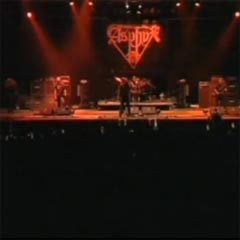
Asphyx make that which is heavy fun and compelling. This could be one of my favorite recorded metal concerts because it captures not only the professionalism, but also the minimal set-up and adornment, as well as the different frequencies of energy this band emit. They convert dark empty spaces to ones filled with a new kind of like, like twilight or morning, in which the darkness is never pure, having been converted to the inertia of day. All band members are professional and precise, and while Martin van Drunen gets his share of camera time, in my view it is the workmanlike and intensely concentrating Bob "Mister Asphyx" Bagchus who steals the show with his serious and intense facial expressions to accompany his exact drumming. Wannes Gubbels, bassist/vocalist late of Pentacle, injects a ton of exuberance, while guitarist Paul Wayyans shows us death metal the original way -- a science and an art that both has to be kept simple and done so that it all makes sense in the end. These 62 minutes of powerful recording span the band's entire career but focus on the classics from The Rack and Last One on Earth, giving us a set with career diversity but also a powerhouse of the songs that defined this band. Video is professionally shot with multiple camera angles, and while effects like the high contrast black and white flash, the rising fake flames, and occasional slo-mo are used, they are not distracting. van Drunen's voice is excellent; I don't know another metal vocalist who can make the guttural sounds of death vocals while keeping a forced scream going at the same time. He is an excellent frontman who both works the crowd, throwing out his ad libs with perfect rhythm to keep motivation high, and a consummate professional who uses his voice as an effective instrument. I think this should be mandatory watching in schools. This review refers to the DVD included with the release of Asphyx Death... The Brutal Way.
B
Bones - "Mayhem on a Cross" +
(Fox, Episode 421, 4-16-09)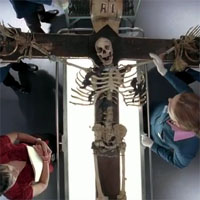
Covering metal as a setting presents a problem for television because it's nearly impossible to reveal much about the genre from a mainstream perspective, especially since it's not the topic of the show. On Bones, the topic is murder and the setting is an underground of black/death/nu-metal bands who use the corpse of a murder victim as a prop. Having followed Temperance Brennan in Dr. Kathy Reichs' books for some years, I was glad to see the show clarified her character. In addition, this show obliquely tackles the issues at the core of death and black metal.
Brennan represents science and rationalism; her counterpart, Seeley Booth, represents monism and aesthetics. The interplay of their characters reminds me of the interaction between Fitzwilliam Darcy (Bones) and Elizabeth Bennet (Booth) in Jane Austen's Pride and Prejudice. Much like people in modern society, they assume Rationalism as a basis of reality but find the details overwhelm them.
In the course of the show, they explore a desire in parallel between the show and the metal bands represented -- how to express the horror of a modern time in a way that makes you like it, and want to use it as a showdown between good and evil, especially evil disguised as good, and how Rationalism -- linear, logical, discrete, symbolic thinking -- can get in the way of understanding our task of understanding ourselves.
Diehards will not be pleased that the genres get lumped together in the bands shown, but will be interested to see the show's clinical psychologist analyze the difference between the two. However, since the show is not about metal, but murder with metal as the setting, the airtime given to these underground genres is generous and the depiction accurate albeit distant.
C
D
Danzig - Archive de la Morte +
(Music Video Distributors, 2004)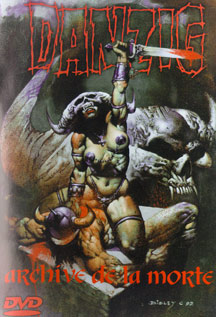
Few underground bands will achieve a video document of this quality. It consists entirely of MTV-style song videos, professionally filmed and edited, which are either miniature movies in which the band is featured or high quality live recordings. The sound quality is excellent, as is the image quality, but having someone take the time to edit and shape the video experience as one might find in a cinema puts these in a different league. However, this DVD has a weak spot, and it is the choice of material.
Where a disc of sloppier and less coherent videos from classic Danzig, namely the first two albums, would be a gigantic hit, there's only one song from that era on here, and while the material from his later albums is good, it's also more typical hard rock/heavy metal and thus does not show this band at their most adept and inventive phase. Furthermore, this DVD is literally an archive, and gives us six songs with up to three versions of the video for each, which makes it not only unsuitable for casual viewing but very limited. Couldn't someone tack on some crappy handheld video of a live set at the end, as, well, that would be more the whole of the Danzig experience than this narrow snapshot?
The videos are quite artistic, and feature heavy symbolism and plenty of evil moments. It culminates in "Mother '93," which is essentially the album track dubbed over some hammy but expertly edited live video. If you are a Danzig fanatic, this provides you with the videos you saw on MTV and the uncensored versions that you probably wanted desperately at the time. For the more casual fan, this video will probably seem like a hasty and unthinking compilation of material that documents the less triumphant moments of an otherwise influential act.
Dark Planet: Visions of America +
(Illuminati, 2005)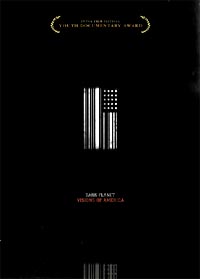
The four genres discussed in Dark Planet - straightedge, skinhead, black metal and zealot - present themselves as alternatives to the mainstream ways we envision our future. Unlike the normal Simpsons-style happy oblivion in which most consumers live, these youth culture groups believe our current path leads to ruin, and are forming breakaway societies.
Luckily, the film takes a documentarian's delicate outsider approach to outsiderness: observe, ask the logical questions, and then boogie. Here is the great strength of their approach: they are able to approach these cultures as an athropologist would, without judging or fearing for their own political futures, because they treat them all so evenhandedly.
If you ask this reviewer, the zealots -- separatist Christian ideologues -- really run away with the show by having a clear plan unlike the other three groups. Their culture, based in distorted loud music as well as the other three, emphasizes a rising above instead of a fighting back or burning the world. Like the other groups, however, their methods do not seem particularly effective.
Seeing these movements compared helps us see the point of this film: that many people agree things are going wrong, but have no idea what to do about it because the insider mainstream is never going to budge from its position of convenience-first, so people are creating alternate societies within societies. This film like all good documentaries provides a visual feast of information with an aftertaste of introspection.
E
F
G
Global Metal +
(Seville Pictures, 2008)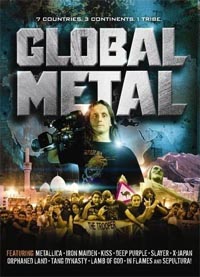
Anthropologist Sam Dunn takes to the air to visit different parts of the world where heavy metal is booming. In doing so, he acknowledges the transition the genre has made from being a developing movement in the west, to a genre which has reached an end to its maturation and now is another voice into which others project.
Indeed, as he visits anti-religious metalheads, religious metalheads, anti-Zionist metalheads and Zionist metalheads, teen rebels and people looking for a voice for their ancestral cultures that can compete with the booming sound of the West, Dunn discovers a change in metal. No longer is it being absorbed by a global audience, but changed by a global audience.
He does this through a winding narrative featuring many shots of the director, often using his bemused poker face to poke innocently where trouble might lie. Knowing that interviews alone make a boring documentary, he intersperses them with tour de force cinematography that shows us the vastness and beauty of these different places, and music videos mostly featuring concert shots from each location.
The intelligent choice here is to avoid "norming" places by emphasizing the we're-all-the-same message. Dunn lets his camera and his subjects do the talking, although his frequent voice-over covers the boilerplate dogma we're accustomed to hearing: metal is about self-expression, freedom, free speech, being an individual, and so on. But as time goes on, we see how metal is about being in a group that accepts the individual's desire for rage and figuring things out themselves.
Dunn's final narrative affirms this: metal is a worldwide subculture to which people belong more than the politics of their nations. It is as if through his eyes, metal is a shout of rage at the modern world which has assimilated culture in its manic desire for power and commerce, and the insurgent forces of Hessians worldwide are reclaiming culture by first distancing themselves from it.
For the person who is rightfully as cynical of the nitwit pretensions of individuals as of the face of state power, many of the people interviewed come across as surface treatments, and this is a general criticism of Dunn's films we have all heard before. In the name of making them accessible, he pushes back the anthropology in favor of reveling in the power of the movement itself. For now, that's not half bad.
H
Heavy: The Story of Metal +
(VH1 productions, 2006)
What is excellent about this documentary is its bonehead simplicity in tracing the history of metal. It focuses on nodal points where single events touched off nascent convergences and caused paradigm shifts. Not all of these are musical events; much of the footage is devoted to showing how changes in history prompted changes in metal. This attitude allows it to peer into the motivation behind metal musicians more than any other documentary extant.
The strength of this documentary is its star power in pulling in all of the classic figures in heavy metal for interviews. The big names show up, and get put at ease and asked questions by people whose journalistic intent matches a fascination with rock music as an event. When their answers are put in context, the result is metal history like a scrolling tapestry passing our eyes.
The centerpiece of this documentary are the glam years of Hollywood bands from Van Halen to Guns and Roses, and much of it is intended to make them look more sophisticated and intense than their European counterparts who invented the genre. Speed metal gets an offhand mention, and underground metal gets entirely skipped. Its focus is not surprisingly on the kind of metal that makes it to the VH1 video channel and makes pots of money.
In its coverage of glam rock, power ballads, bad boy rebels and drug abuse this film is most lucid. Humorously, the glam rockers, twenty years later, look somewhat diseased, while Tommy Lee still looks vile and combat-ready. Even funnier: of all the people interviewed, a remarkably self-confident and unpretentious Sebastian Bach is the most articulate and uncomplicated. Unfortunately, other parts of the film portray metalheads as wounded, out-of-control children who make this horrible, violent music because they're defective.
While these flaws weaken the documentary, and disable it more in post-viewing analysis when the viewer realizes the documentary's weaknesses stem from a desire to productize one of the last un-zombie'd genres, "Heavy: The Story of Metal" has many positive factors, not least of all the simplest: the people who made it clearly enjoy metal music and wanted to portray it in a positive light, even if their definition of positive was twisted by their pocketbooks.
I
J
K
L
M
Metal: A Headbanger's Journey +
(Warner Home Entertainment, 2006)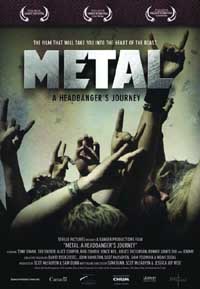
I just saw this at the Alamo Drafthouse, and I was surprised at how much I enjoyed it. It is probably the most watchable movie on the topic thus far, as it actually has a budget and properly addresses the many subgenres. It stays focused on the more populist bands (Wacken is a prominent setting) but I find that getting into all the underground minutiae bottoms out these days because whether people are motivated by commerce or popularity, the effect on the music is just as deletrious. Sam Dunn, the filmmaker, is a contemporary of the 1980s metal (30-ish, grew up on thrash and death metal, cites Autopsy as one of his favorite bands) so it is worth supporting and good fun. The interview with Gaahl and then Dio repeatedly ripping on Gene Simmons are worth the price of admission.
by David Anzalone
Metalheads +
(Bill Zebub, 2003)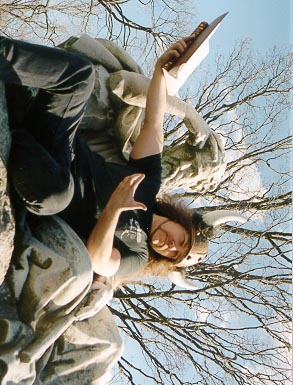
For the first video review to ever grace these pages a film was chosen that is valuable for the conclusions gleaned from its perception, and not necessarily the art of moviemaking exhibited. Following the pattern of most first films, this work starts with a group of characters and mocks them in their ouroboric paths to nowhere. In doing so, it reveals something of the nature of the metal community itself, both through its dominant symbols - drugs, masturbation, anger, fatalism - and through its own fascination and the conclusion it is able to draw.
Shot in conveniently sparse videocam, the movie romps through a series of goofy but enjoyable skits and long derangements of the senses synchronized in form to music, giving it the feeling of a music video + home video + low-budget film in one. Of note are musical choices, which showcase a DJ's eye for context. There is ample T&A of a tame variety and gratifying indulgence in all forms of base humor, including masturbation, fecalism and amusing violence. Highlights include a series of blown-out female characters who are preachy but have the sexual ethics of a Grimoire Girl(tm), a fantastically fascist cop played by Craig Pillard, and several utterly believable stoner/metalhead characters who wander around in a haze of mostly their own creation. Absent is any moralism regarding the world around us; it is nice to escape that moralistic confine in which most contemporary filmic art is launched.
Another highlight is "Ox," who barges his way onto the set and provides one of the most believable character satires of pure rampaging destruction in human form yet found. Toward the beginning and end of the film, when it needs extra impetus, there is booster rocket material from what are now basic digital editing effects, which to the director's credit are often quite cleverly applied ("making the most of what you have"). Is the movie "good"? No and yes. It's hard to sit through some of this; the scenes are long and often tediously embarrassing to the degree that sympathy is lost for the characters and even the joke. As a whole, the plot is light, with three or four major devices and a linear narrative based on its precepts. It's sometimes difficult to watch from a combination of ineptitude and padding. However, it is "good" in that this movie has a large amount of perceptive content for a cut-up laugh fest, and while its methods and often gags are cheap and sometimes predictable, they're carried out with a unique flair and nurture for the humor involved.
Like any modern comedy, the plot is a container for almost granularized skits woven roughly into the context of the people who drive changes in the action, and this approach works for the scattershot method required to address the diverse complexity of intellectual representation of external reality in this era. The acting isn't great, but Zebub himself is a high-energy riot of comedic momentum who can be witty in a pinch, or subtly humorous over the length of a scene. His supporting cast perform well compared to many card-carrying actors and, while like in the movie itself we can see rough edges there are imperfections galore, they link up in the film like prisoner sex. While this movie gets a somewhat ambivalent recommendation, the idea of pursuing the next professional offering from Bill Zebub is not at all ambiguous to this reviewer.
The Michael Schenker Group - Live in Tokyo 1997 +
(Minutes/Music Video Distributors, 2004)
Despite the cheesy low-budget titles which preceded the actual performance, this video is quite competent. Video quality is high, color balance is good, and sound is as near to pristine as one can get through this medium. The problem is that it is filmed like a Bon Jovi live set, with too much focus on the vocalist and a total shortage of the crucial closeups of guitar playing that should accompany performances by people renowned for their instrumental ability. Is that rocket science, or what?
We get plenty of wide-stage views and frontal closeup of "emotional" moments during the singing, but a fault of tight shots and creative angles. Tastefully the filmmakers avoid too much crowd interaction, which is smart since if one's best qualification is having bought a ticket, it is probably not a sign that one has much to say/gesture of note. For this reviewer, the music on this DVD was too much of the hard rock variety, but it is clear that the performers are highly talented and it is hoped that with their next video release, there will be more focus on things of interest to musicians or people who simply admire classic guitar playing.
N
O
P
Q
R
S
Samhain - Live in 1984 at Stardust Ballroom, Hollywood +
(Music Video Distributors, 2004)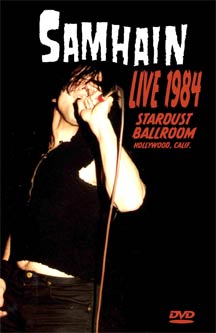
This hand-filmed, single-camera narrative documents a time when underground music was still struggling to find its path, and while the quality may not be that of a slick professional recording, the delivery of the band is captured in as much detail as is needed. The sound, when it is not cutting out, is good and separation between instruments and vocals can be heard clearly.
Glenn Danzig is an energetic vocalist without either the jaded reserve or overindulgent showmanship of later years, and the crowd looks shellshocked and unsure of what they're seeing, which has the advantage of them doing fewer stupid things to mar enjoyment of the performance. The band are economical with their onstage motions, and tight in their playing, which gives these songs the same power they have coming off of a CD. An enclosed sticker provokes some nostalgia for the time, an age of xeroxed posters and grimly absurd art, of people gathering in long-forgotten clubs to bash out violent performances. For those who like what Samhain were about, this DVD is everything that could be desired from this foundational band.
T
U
Until the Light Takes Us +
(Audrey Ewell and Aaron Aites, 2008)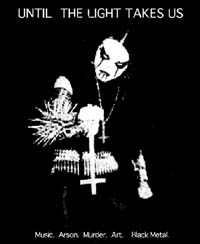
If we ask why instead of how an event happened, we find out what made the humans behind it do as they did. "Until the Light Takes Us" explores the why of early 1990s Norwegian black metal. Designed for people with no knowledge of that subculture, the film explains the black metal movement while making its actors emotionally accessible so we feel an urge to understand it.
In a time of a sudden interest in metal documentaries, this film stands out by exploring the personalities and ideals that made people invent the music; other films look at the facts of how the music was invented but never the why. We don't need another documentary telling us millions of people worldwide go crazy for heavy metal so it's OK if we want to as well. We need to figure out what makes people pick this genre over every other.
"Until the Light Takes Us" gets into the why of black metal and the church arsons, murder and media circus that followed. Through fragments of media footage, interviews, and footage of black metal musician Fenriz as he prepares to visit an art exhibit about black metal, this film explores the clash between fantasy and utilitarian modernity that sparked the radicalization of heavy metal.
At its culmination, the documentary shows past colliding with present, and a fervent ideal of being against the modern world and believing in a mythic life full of fantasy, adventurous violence and conflict. It is both poignant and literal, like black metal a collision of alienated punk gumption and epic dreams. Like black metal, this film is a study of moods, overlapping in translucent layers, which as they are pulled away show us a simple shape of truth.
Although some have bemoaned the inclusion of too much Varg or Fenriz, it became clear from other interviews that musicians are not an articulate bunch and the two who get the most screen time do so in part because they can explain themselves coherently. In the case of Varg, he's easy to watch: he's funny, sharp, friendly and his logic is lucid. Fenriz is moodier but his dark sense of absurdist humor commands the film.
At the core of this genre, Ewell and Aites find a revolution against consumerism, equality, uniformity, utilitarianism and all other modern concepts by 35-year-old teenagers who never gave up on the idea that life should have adventure, constant discovery and a sense of meaning that unites the entire experience. Unlike most people, these individuals are fully aware of what death means, and when contrasted with the robotic plastic surroundings of the modern world, a parallax shift occurs: we go from seeing them as out of place to seeing their surroundings as out of place or perhaps, irrelevant.
This film is a cipher, in that it gives us many entry points to a questioning of modern society and exploration of the ideas of black metal. Among other things, it is obsessed with the erasure of memory and culture, an inspection of the culture of convenience and the isolation it brings, and a hint that we should explore what Joseph Campbell calls "mythic imagination" and Varg calls "fantasy." Without being socially critical, it is an exploration through the eyes of those who made black metal, and then saw it erased as it became a product with the passage of time.
Metal has been crying out for a movie like this for decades. "Until the Light Takes Us" does what even metalheads cannot do most of the time: it takes the genre seriously as an art form, and peers behind the outlandish behavior and image to try to understand what motivates people to cast aside society for evil metal. For this alone this film should be praised, but it very quietly exposes metal like a blueprint, all while showing us the emotions of the people involved. It is compelling.
Clearly these filmmakers knew how to ask the right questions and patiently wait for their subjects to articulate their points of view, then snatch the moments of greatest clarity and present them with impact. Scenes of industrial desolation follow the impact of strident words, and fires of ancient churches melt into shots of the memorabilia and essential moments of a developing genre.
Each fan will probably have a wishlist for changing this film, but that only shows how much it seizes the imagination. I would enjoy seeing a comparison between black metal and the European Romantic literature, theatre and music of two centuries ago. Others have commented that less Frost (of Satyricon) might accelerate the latter half, but this reviewer was not troubled by either detail.
While much of the material in the movie is well-known in the form that leaked out through the media, rediscovering it through this artfully told history is a dream come true. The documentarians hide themselves and let the characters tell their own side of it. What makes it a dream to which we'd like to return is that it explores the why of this music, and in doing so shows us the fans why we found so much hope and possibility in black metal.